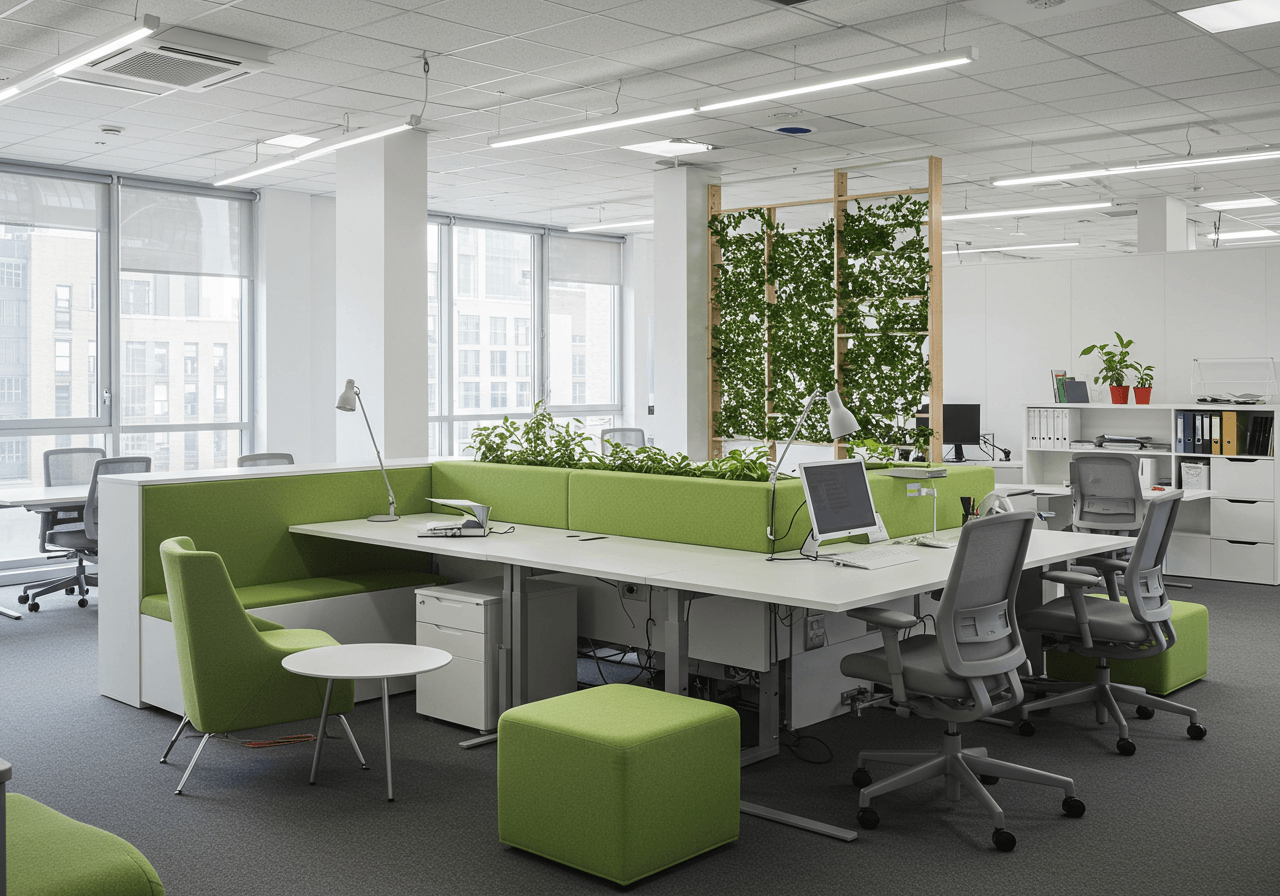
Office Design: enhancing productivity and well-being
Office design is an essential asset for any company aiming to optimize both employee comfort and overall performance. A well-thought-out layout that incorporates ergonomics and aesthetics can greatly influence daily motivation and team cohesion. In the following paragraphs, you will discover how space planning, lighting, furniture selection, and corporate culture all combine to create an environment conducive to efficiency and well-being.
When redesigning an office, it is important to consider how teams interact and how tasks are distributed. In a poorly arranged space, employees may experience fatigue, stress, and distraction, leading to decreased productivity. Conversely, a pleasant environment fosters a sense of belonging and encourages collaboration. The goal is therefore to create a space where people feel comfortable, without sacrificing operational needs.
The importance of ergonomics
Ergonomics directly impacts individual health and concentration. Chairs that properly support the back, desks set at the right height, and unobstructed walkways are a few examples of best practices. Well-chosen furniture helps prevent muscle strain and promotes proper posture.
Provide work surfaces that allow forearms to rest comfortably.
Select adjustable chairs that suit different body types.
Ensure storage is easily accessible to keep the space clutter-free.
These simple measures significantly reduce accumulated fatigue. Employees feel more energetic and can complete their tasks under better conditions. They also save time in an office that remains organized and functional.
Fostering an environment conducive to focus
Acoustics and lighting are two crucial factors. An overly noisy setting can create constant disturbances, while insufficient natural light may lead to drowsiness. In an optimized office design, workstations are placed near windows, and adjustable lighting is installed to offset any lack of daylight.
Reduce noise by using partial partitions or sound-absorbing panels.
Use adjustable desk lamps so each person can set the desired brightness.
Combine various light sources (ceiling fixtures, wall sconces, floor lamps) to vary the ambiance.
Better visual and auditory comfort helps lessen stress and fatigue. Teams remain more focused and organize their tasks more effectively.
Steps for a successful layout
Following a structured process is advisable when rethinking a workspace. Below is a numbered list of key milestones:
Analyze usage: observe the current setup and identify strengths and weaknesses.
Define a project brief: clarify the goals of the layout and the desired style.
Select materials: prioritize durability, practicality, and an aesthetic in line with the company’s image.
Plan the implementation: coordinate the work and monitor deadlines.
Gather feedback: ask users for input and make any necessary adjustments.
Sustain improvements: revisit the space if needs change over time.
This approach helps avoid inconsistencies and ensures results that meet expectations. It also allows for better anticipation of budgetary and technical constraints.
The role of corporate culture
Office design should be in harmony with the company’s identity. The choice of colors, shapes, and materials depends on the organization’s values, its sector, and the image it seeks to convey. An ecology-focused business might opt for recycled materials or greenery, while a creativity-driven firm might choose modular furniture and bolder colors.
In keeping with this approach, it can be beneficial to encourage personalization of the workspace so that employees feel free to make it their own. Without allowing disorder, letting people add a few decorative items or personal plants creates a warm atmosphere and motivates teams to become more involved.
Concrete benefits of a good setup
A thoughtfully conceived office design yields multiple advantages:
Less fatigue: proper posture, comfortable reading distances, and adequate lighting.
Better collaboration: informal meeting areas that support idea-sharing and spontaneity.
Reduced stress: unobstructed pathways, managed noise levels, and relaxation areas where people can recharge.
Enhanced image: partners and applicants perceive a professional, dynamic setting.
Ultimately, the company benefits by boosting competitiveness, since a quality environment supports performance and curbs turnover. Employees, for their part, are more inclined to participate and share ideas when they feel heard and respected.
Ideas to boost well-being
Certain initiatives help establish a friendly, motivating atmosphere:
Set up a coffee corner with comfortable chairs and welcoming decor.
Introduce shared lockers to foster community spirit and reduce clutter.
Create a board where people can leave messages, propose projects, or announce upcoming events.
These small details improve cohesion and creativity. Employees can interact in a more relaxed setting, which strengthens team spirit.
Two additional lists to refine the project
Points to watch out for during the design phase
Check the quality of natural light: do not block windows with large furniture.
Ensure thermal comfort: plan for effective, well-distributed heating or air conditioning.
Think about storage solutions: keeping things orderly helps with flow and limits distractions.
Adapt the size of meeting rooms: some are for small groups, others for larger audiences.
Ways to strengthen visual identity
Display the company’s brand in the decor (wallpaper, logos, consistent color schemes).
Use materials that reflect the brand image (wood, metal, glass), depending on the intended positioning.
Highlight in-house achievements: dedicate a wall to projects or awards.
Measuring results and making adjustments
After the changes are in place, it is crucial to gather input from the main users of the space. Honest feedback helps identify strengths and address any issues that were not initially anticipated. Some layout decisions may need fine-tuning, such as desk placement or how often certain spaces are utilized.
These observations guide future modifications, ensuring the workspace remains inviting and efficient. Evolving work methods, staffing levels, and technological requirements can also prompt regular adjustments.
Guidance from a specialist
Redesigning an office can be challenging when one has to single-handedly handle furniture selection, coordinate the work, and ensure consistency. Bringing in a workspace design professional saves time and reduces the risk of errors.
RK Interiors assists clients throughout this process. Through a detailed assessment of needs, a creative approach, and a focus on sustainable solutions, the team delivers a project that suits both the budget and the company’s strategy. Each step is validated collaboratively, guaranteeing results that are aesthetic, ergonomic, and true to the corporate culture.
Review and outlook
Designing a workspace goes well beyond simply choosing furniture. It involves careful consideration of ergonomics, lighting, acoustics, and the setup of collaboration areas. Office design should reflect the company’s values while addressing the concrete needs of teams, aiming to bolster efficiency and safeguard everyone’s well-being.
By focusing on fundamental aspects (suitably adapted workstations, balanced lighting, noise reduction, unobstructed circulation) and introducing personal touches (decor, social areas, relaxation corners), a business can boost its appeal and competitiveness. The benefits become evident not only in day-to-day employee satisfaction but also in how the public and partners perceive the organization.
To succeed with this plan, it is advisable to consult experienced professionals. RK Interiors strives to understand the culture of each company in order to shape offices that align with its ambitions. Over time, this comprehensive, tailored approach proves to be a smart investment, creating a harmonious environment that encourages fulfillment.

